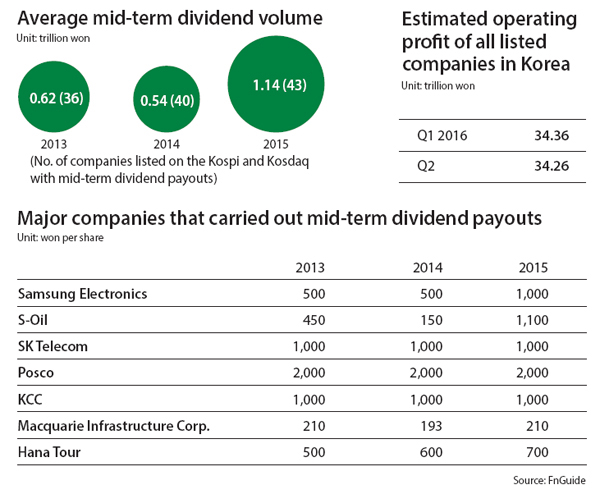Dividends are raising the popularity of ETFs

The popularity of dividend-themed ETFs has surged since more listed companies of all sizes have raised the amount of their dividends and come up with shareholder-friendly policies at their shareholders’ meetings in March.
The government’s carrot-and-stick approach, in which incentives are offered to dividend-paying companies while a heavier tax is imposed on those more hesitant, was a major contributor in the trend. When the policy was announced, Hyundai Motor and Woori Bank last year started paying out midterm dividends.
According to FnGuide, an online fund evaluation company, 43 companies listed in the primary Kospi and tech-heavy Kosdaq markets distributed midterm dividends worth a total of 1.14 trillion won ($957 million) last year. This was more than double the 539.7 billion won paid out in June 2014.
Experts say investors can expect plenty of dividends this year, thanks to the enhanced business performances with belt-tightening by listed firms.
Kospi-listed firms are estimated to have recorded operating profits of about 68.62 trillion won altogether in the first half of this year, up 17 percent compared to the same period last year, according to the FnGuide. IT, telecommunications, financial, petrochemical and consumer goods makers are forecast to see enhanced business performance.
Market bellwether Samsung Electronics posted 49 trillion won in first-quarter revenue, up 4 percent compared to a year earlier, and 6.6 trillion won in operating profit, about 10.4 percent higher. LG Chem even saw its operating profit surge by 26.6 percent year-on-year during the first quarter.
“Petrochemical shares have seen improved performances thanks to high sales oriented from low crude prices, and many Kospi-listed companies displayed better-than-expected profits in the first quarter,” said Park Seok-hyun, an analyst at Eugene Investment & Securities. “More Kospi-listed companies will keep enjoying rising profits and eventually uplifting the entire index in the second quarter.”
Analysts, therefore, suggest that more investors pay attention to companies with strong dividend payouts.
“Dividend policy is something that a company can’t easily change, because it’s a promise jointly made with shareholders,” said Kim Yong-koo, an analyst at Hana Financial Investment. “That’s why I recommend investors put strong-dividend equities at the top of their list.”
Twenty-nine listed companies have steadily paid out midterm dividends in the past three years. Samsung Electronics, Posco, SK Telecom and Hana Financial Group are some of the best and most consistent dividend payers.
Traditionally, firms in the utility, telecommunications and financial sectors have offered high dividend payouts, as these industries are sensitive to government regulation changes.
Posco and Shell Korea have given out 2,000 won per share in midterm dividends over the past three years, while SK Telecom and KCC, a construction materials maker, paid out 1,000 won per share.
This year, Woori Bank, which saw better-than-expected first-quarter profits, is forecast to pay midterm dividends of about 250 won per share. The bank saw its first-quarter net profits spike by 52.4 percent this year compared to the same period last year to 443.3 billion won, after getting rid of insolvent debts and increasing lending.
Ahead of the midterm dividend payout season, about 311.8 billion won in net assets flocked to dividend-themed ETFs as of Monday.
More than 20 billion won has moved to this type of funds since the beginning of the year. These ETFs follow locally listed indices like Kospi Dividend Growth 50 and Kospi 200 High-Dividend, two indices that consist of equities that offer exceptional dividends.
The dividend-themed ETFs saw an average return of 3.4 percent in the first five months, much higher than the average of local equity-based ETFs’ negative 0.25 percent.
“For those investors who feel it is risky to allocate money for individual dividend-paying equities, the dividend-themed ETFs can be a safer alternative,” said Cho Jae-young, a senior consultant at NH Investment & Securities Gangnam Private Banking Center.
BY KIM SUNG-HEE [kim.jiyoon@joongang.co.kr]










with the Korea JoongAng Daily
To write comments, please log in to one of the accounts.
Standards Board Policy (0/250자)